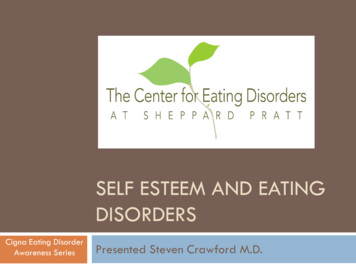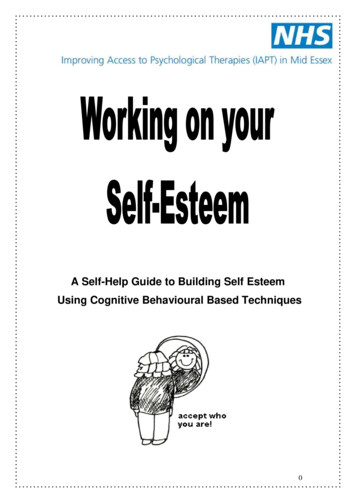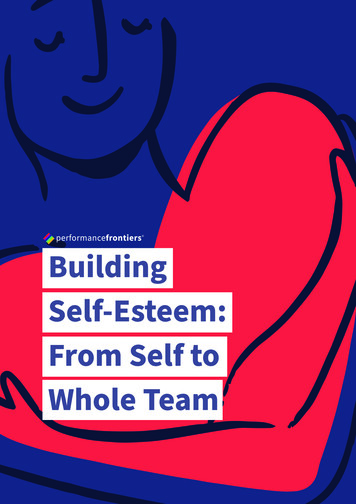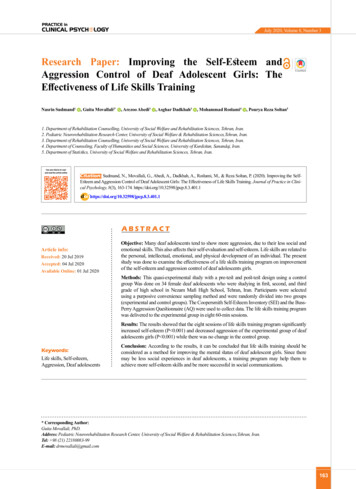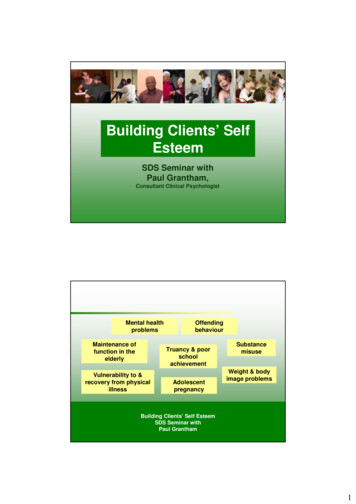
Transcription
Building Clients’ SelfEsteemSDS Seminar withPaul Grantham,Consultant Clinical PsychologistMental healthproblemsMaintenance offunction in theelderlyOffendingbehaviourTruancy & poorschoolachievementVulnerability to &recovery from eight & bodyimage problemsBuilding Clients’ Self EsteemSDS Seminar withPaul Grantham1
Older peopleChildren &Schooling(Robins et al 2002)Mental healthproblemsSubstanceMisusers(Scott 2004)(Hakim-Larsen &Mruk 1998)Offenders(Pekala 2004)(Toch 2000)Sexual healthParenting(Harris et al 1992)(Stewart-Brown 2004)Building Clients’ Self EsteemSDS Seminar withPaul Grantham‘Self esteem is the lived statusof ones competence in dealingwith the challenges of living ina worthy way over time’Mruk (1999)Building Clients’ Self EsteemSDS Seminar withPaul Grantham2
‘Self esteem is accepting &valuing yourself whilst doingthings competently and in away you find morallyacceptable’Paul Grantham (1999)Building Clients’ Self EsteemSDS Seminar withPaul GranthamWho Of These Has High Self Esteem ?Building Clients’ Self EsteemSDS Seminar withPaul Grantham3
Mruk (1999)WorthinessDefensive SelfEsteem (1) 10High Self EsteemCompetenceCompetence- 10 10Classic Low SelfEsteemWorthinessDefensive SelfEsteem (2)- 10Building Clients’ Self EsteemSDS Seminar withPaul GranthamMruk (1999)WorthinessDefensive SelfEsteem (1) 10High Self EsteemCompetenceCompetence- 10 10Classic Low SelfEsteemWorthinessDefensive SelfEsteem (2)- 10Building Clients’ Self EsteemSDS Seminar withPaul Grantham4
How Do People Develop High Self Esteem?Being valued by significant othersReceiving positive feedback on competence & valueClear & consistent boundary setting and expectationsHaving excellent role models dealing with challengeBelonging to a social group(s) with high self esteemBuilding Clients’ Self EsteemSDS Seminar withPaul Grantham5 Key Sources of Self EsteemDeveloping self efficacyCognitive approaches to change thinking andbeliefsThe use of self nurturing and selfenhancement strategiesDeveloping social support to enhance selfesteemReceiving effective feedbackBuilding Clients’ Self EsteemSDS Seminar withPaul Grantham5
Developing Clients’ Self EfficacySuccessfully handling the‘challenges of living’Successful goal settingSuccessful influencingBuilding Clients’ Self EsteemSDS Seminar withPaul GranthamIncreasing Self EfficacyThe importance of positive role models?Real life and distance role model?How can we use role models?Building Clients’ Self EsteemSDS Seminar withPaul Grantham6
Increasing Self EfficacyThe use of problem solving to manage the challenges of lifeGive permission for mistakesHow to spot if there is a problemHow to make sense of the problemFinding different possible solutions or responses to theproblemThink about effectsMake a planImplement and evaluateBuilding Clients’ Self EsteemSDS Seminar withPaul GranthamIncreasing Self EfficacyEnsuring Successful Goal SettingMaking goal setting integralThe issue of goal choice and directionIdentifying benefitsAnticipating obstacles and how to address themBeing flexibleEncouraging clients to revel in successesUsing support systemsBuilding Clients’ Self EsteemSDS Seminar withPaul Grantham7
Increasing Self EfficacyDeveloping Assertion SkillsWhy are we not more assertive ?The right to make our needs and wants heardHow to do it (Saying No)Keeping calm while you do itKeeping a record of successes and effectsBuilding Clients’ Self EsteemSDS Seminar withPaul GranthamUsing Cognitive ApproachesRaising awareness of verbal thoughts,beliefs, values and imagesMaking the connection betweenthoughts/beliefs and feelings/behaviourExamining ‘unhelpful’ thinkingCreating doubt rather than changingbeliefsBuilding Clients’ Self EsteemSDS Seminar withPaul Grantham8
Common forms of ‘unhelpful’ mping to conclusionsMagnifying‘Yes, but ’‘Should’ statementsName callingPersonalisingFortune tellingBuilding Clients’ Self EsteemSDS Seminar withPaul GranthamCognitive TechniquesRecord keepingSelf statements(mantras)Thoughts & alternativesRebuttalsThoughts & contraryexamplesPositive self statementsThoughts & rebuttalsSocratic dialoguesPersonification, tone &volumeBuilding Clients’ Self EsteemSDS Seminar withPaul Grantham9
Building Clients’ Self EsteemSDS Seminar withPaul GranthamThe role of self nurturingBody maintenanceBody enhancementBuilding Clients’ Self EsteemSDS Seminar withPaul Grantham10
Exercise & Self EsteemWhat type of problems does it work with?Mental healthPhysically DisabledObesityRaglan (1990)Coyle & Santiago (1995)Ready (1991)Pre-School ChildrenYoung OffendersThe ElderlyMacMahon (1990)Lampman (1987)Alpert et al (1990)Myocardial InfarctionChildrenWaade (2004)EpilepsyConn et al (1992)Van Linschotton (1990)Building Clients’ Self EsteemSDS Seminar withPaul GranthamWhy does exercise build self esteem ?DistractionMonoamine metabolism and endorphin releaseSense of increased control of selfPerception of success & achievementMeditative effectPerceptions of improving physical condition & bodyattractivenessBuilding Clients’ Self EsteemSDS Seminar withPaul Grantham11
Body EnhancementCosmetics Use – Brdar et al (1996)Clothing Use – Fiore & DeLong (1990Hairdressing - LGFBBuilding Clients’ Self EsteemSDS Seminar withPaul GranthamUsing Social Support & HelpImportant characteristics of social networksSizeUsePerceptionBuilding Clients’ Self EsteemSDS Seminar withPaul Grantham12
Social Support NetworksWhy do they increase self esteem?Aid self acceptanceSuggestibilityincreases hope andbelief in successReduces senseof isolationExtra resourcesfor problem solving,guidance & practicalhelpSomeone to disclose toIncreases perseverance totackle problemsBuilding Clients’ Self EsteemSDS Seminar withPaul GranthamKey methods for improving clients’ socialsupport & networksAdd membersTeach clients how to use their networks moreeffectivelyEnhance clients’ perceptions of existing socialnetworks & support (Brand 1995)Building Clients’ Self EsteemSDS Seminar withPaul Grantham13
How to use the people you know betterHow NOT to talk to peopleThings to say and do to get people to like youWhat to do with your body and faceChoosing who to practice withBuilding Clients’ Self EsteemSDS Seminar withPaul GranthamEnhancing perceptions of social supportGetting More From Your Friends & FamilyList all the people you know :Circle those you talk to at least once a week/monthList something each does for you over the nextweek/monthBuilding Clients’ Self EsteemSDS Seminar withPaul Grantham14
Obtaining Accurate FeedbackFeedback as a source of information about selfPositive vs negative feedbackThe importance of type, salience and frequencyBuilding Clients’ Self EsteemSDS Seminar withPaul GranthamHow to give ‘good feedback’If performance is VERY bad, attend to your client and‘appreciate’ them their unique characteristics‘Catch your client doing things right’Repeatedly & frequently let them know about itGive feedback at the start/middle, get eye contact, beconcrete and specific and don’t collude afterwardsProvide positive and negative feedback on a ratio of5:1 (Frey & Carlock 1989)Building Clients’ Self EsteemSDS Seminar withPaul Grantham15
Feedback ExerciseGiven morethan gotBuilding Clients’ Self EsteemSDS Seminar withPaul GranthamKey learning pointsDoes your client have self esteem issues on competency,worthiness or both? Don’t address the wrong issue !Explore the use of role models. They are frequently under used inself esteem workWatch out for the clients’ own language for describing theircognitions. Then use it !Don’t rule out how clients LOOK in building self esteem. SOMEform of exercise is near enough essentialLoners rarely have high self esteem. Look at building socialnetworksNegative feedback is always easier to take if you know what’salready unique or good about youBuilding Clients’ Self EsteemSDS Seminar withPaul Grantham16
Building Clients’ Self Esteem SDS Seminar with Paul Grantham Key learning points Does your client have self esteem issues on competency, worthiness or both? Don’t address the wrong issue ! Explore the use of role models. They are frequently under used in self esteem work Watch out for t




